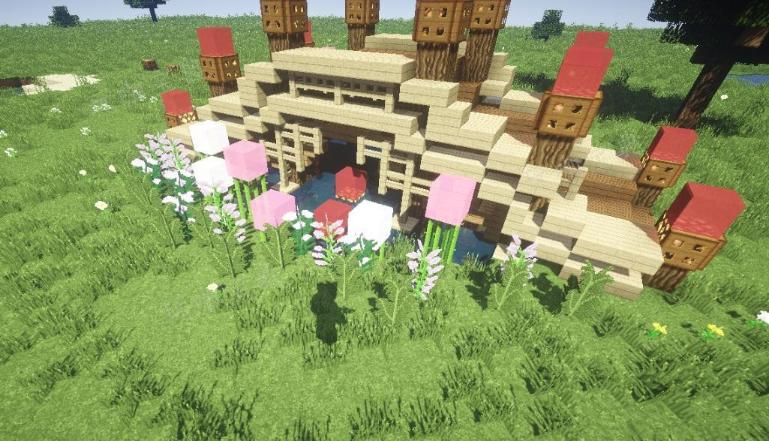How to transfer a homeowner in "Minecraft"?
php editor Xigua explains in detail how to transfer homeowners in "Minecraft". In the game, homeowners can choose to transfer their rights to other players and make them new homeowners. This process involves some steps and operations, and players need to follow the instructions to successfully complete the transfer. Next, we will explain how to transfer the owner in Minecraft one by one, so that you can easily master this skill.
In "Minecraft", many players will set up their own servers or multiplayer rooms to share this boundless world with their friends. But then there is the possibility that managers or “homeowners” need to transfer their location to someone else for a variety of reasons. How to conduct a homeowner transfer correctly and efficiently? Below is a thorough guide.

We need to understand the basic operation of multiplayer game rooms or servers in "Minecraft". Unlike single-player games, multiplayer interaction involves the mechanism of network communication and data saving, which means that the transfer of the homeowner is not A simple "name change" operation involves an important process of power and data management.
Confirm the identity of the successor: Make sure that you and the player who is planning to take over have reached an agreement, and both parties have completed the transfer process online.
Backup world data: It is highly recommended to back up the current world before transferring the owner. The purpose of this is to prevent data loss due to unexpected circumstances.
Understand the transfer steps: Understanding the detailed transfer steps and possible precautions in advance can help you complete the entire process more smoothly.
Start the game: The original homeowner needs to start "Minecraft" on his mobile phone and enter the previously created multiplayer game world.

Enter the game settings: In the game interface, click the pause button, and then select the "Setting" option.
Manage players: In the settings menu, find "Manage Players" or a similarly named option. This section displays a list of all players who have joined the world.
Change permissions: In the selected player menu, change the permissions to "Owner" or "Admin", depending on the specific game version.
Confirm transfer: After completing the permission changes, return to the main game interface and notify the successor player to confirm whether the corresponding permissions have been obtained.
Keep communication open: When performing a transfer operation, make sure to maintain open communication with the succeeding player so that problems encountered during the operation can be solved in a timely manner.
Prevent data loss: Again, be sure to back up your world data before transferring to avoid accidents during the transfer process.

Rights and Responsibilities: Please clearly inform the successor that the host not only has higher game management authority, but also assumes the responsibility of managing and maintaining the game environment.
Permission changes do not take effect: If the player who takes over after the operation does not obtain the expected permissions, it is recommended to re-enter the game and repeat the above steps, or check whether the game version supports this operation.
Data loss: If you fail to back up world data in advance and encounter data loss, you can try to contact the game’s official customer service for help, but recovery possibilities are limited.
Operation error: If there is a problem caused by an operation error, exit the game immediately and restore data from backup.
The homeowner transfer process in the mobile version of "Minecraft" is actually very simple. As long as you follow the above steps step by step, you will basically not encounter any big problems. As an operation involving the transfer of power, it must be taken seriously. Maintain good interaction and respect with the game community so that every player who enters your world can have an enjoyable and safe gaming experience. Have fun with Minecraft and unleash your creativity!
The above is the detailed content of How to transfer a homeowner in "Minecraft"?. For more information, please follow other related articles on the PHP Chinese website!

Hot AI Tools

Undresser.AI Undress
AI-powered app for creating realistic nude photos

AI Clothes Remover
Online AI tool for removing clothes from photos.

Undress AI Tool
Undress images for free

Clothoff.io
AI clothes remover

Video Face Swap
Swap faces in any video effortlessly with our completely free AI face swap tool!

Hot Article

Hot Tools

Notepad++7.3.1
Easy-to-use and free code editor

SublimeText3 Chinese version
Chinese version, very easy to use

Zend Studio 13.0.1
Powerful PHP integrated development environment

Dreamweaver CS6
Visual web development tools

SublimeText3 Mac version
God-level code editing software (SublimeText3)

Hot Topics
 1386
1386
 52
52
 How to use sql datetime
Apr 09, 2025 pm 06:09 PM
How to use sql datetime
Apr 09, 2025 pm 06:09 PM
The DATETIME data type is used to store high-precision date and time information, ranging from 0001-01-01 00:00:00 to 9999-12-31 23:59:59.99999999, and the syntax is DATETIME(precision), where precision specifies the accuracy after the decimal point (0-7), and the default is 3. It supports sorting, calculation, and time zone conversion functions, but needs to be aware of potential issues when converting precision, range and time zones.
 How to create oracle database How to create oracle database
Apr 11, 2025 pm 02:36 PM
How to create oracle database How to create oracle database
Apr 11, 2025 pm 02:36 PM
To create an Oracle database, the common method is to use the dbca graphical tool. The steps are as follows: 1. Use the dbca tool to set the dbName to specify the database name; 2. Set sysPassword and systemPassword to strong passwords; 3. Set characterSet and nationalCharacterSet to AL32UTF8; 4. Set memorySize and tablespaceSize to adjust according to actual needs; 5. Specify the logFile path. Advanced methods are created manually using SQL commands, but are more complex and prone to errors. Pay attention to password strength, character set selection, tablespace size and memory
 How to delete rows that meet certain criteria in SQL
Apr 09, 2025 pm 12:24 PM
How to delete rows that meet certain criteria in SQL
Apr 09, 2025 pm 12:24 PM
Use the DELETE statement to delete data from the database and specify the deletion criteria through the WHERE clause. Example syntax: DELETE FROM table_name WHERE condition; Note: Back up data before performing a DELETE operation, verify statements in the test environment, use the LIMIT clause to limit the number of deleted rows, carefully check the WHERE clause to avoid misdeletion, and use indexes to optimize the deletion efficiency of large tables.
 How to add columns in PostgreSQL?
Apr 09, 2025 pm 12:36 PM
How to add columns in PostgreSQL?
Apr 09, 2025 pm 12:36 PM
PostgreSQL The method to add columns is to use the ALTER TABLE command and consider the following details: Data type: Select the type that is suitable for the new column to store data, such as INT or VARCHAR. Default: Specify the default value of the new column through the DEFAULT keyword, avoiding the value of NULL. Constraints: Add NOT NULL, UNIQUE, or CHECK constraints as needed. Concurrent operations: Use transactions or other concurrency control mechanisms to handle lock conflicts when adding columns.
 What are the oracle11g database migration tools?
Apr 11, 2025 pm 03:36 PM
What are the oracle11g database migration tools?
Apr 11, 2025 pm 03:36 PM
How to choose Oracle 11g migration tool? Determine the migration target and determine the tool requirements. Mainstream tool classification: Oracle's own tools (expdp/impdp) third-party tools (GoldenGate, DataStage) cloud platform services (such as AWS, Azure) to select tools that are suitable for project size and complexity. FAQs and Debugging: Network Problems Permissions Data Consistency Issues Insufficient Space Optimization and Best Practices: Parallel Processing Data Compression Incremental Migration Test
 How to clean all data with redis
Apr 10, 2025 pm 05:06 PM
How to clean all data with redis
Apr 10, 2025 pm 05:06 PM
How to clean all Redis data: Redis 2.8 and later: The FLUSHALL command deletes all key-value pairs. Redis 2.6 and earlier: Use the DEL command to delete keys one by one or use the Redis client to delete methods. Alternative: Restart the Redis service (use with caution), or use the Redis client (such as flushall() or flushdb()).
 How to delete all data from oracle
Apr 11, 2025 pm 08:36 PM
How to delete all data from oracle
Apr 11, 2025 pm 08:36 PM
Deleting all data in Oracle requires the following steps: 1. Establish a connection; 2. Disable foreign key constraints; 3. Delete table data; 4. Submit transactions; 5. Enable foreign key constraints (optional). Be sure to back up the database before execution to prevent data loss.
 How to add multiple new columns in SQL
Apr 09, 2025 pm 02:42 PM
How to add multiple new columns in SQL
Apr 09, 2025 pm 02:42 PM
Methods to add multiple new columns in SQL include: Using the ALTER TABLE statement: ALTER TABLE table_name ADD column1 data_type, ADD column2 data_type, ...; Using the CREATE TABLE statement: CREATE TABLE new_table AS SELECT column1, column2, ..., columnn FROM existing_table UNION ALL SELECT NULL, NULL, ..., NUL




